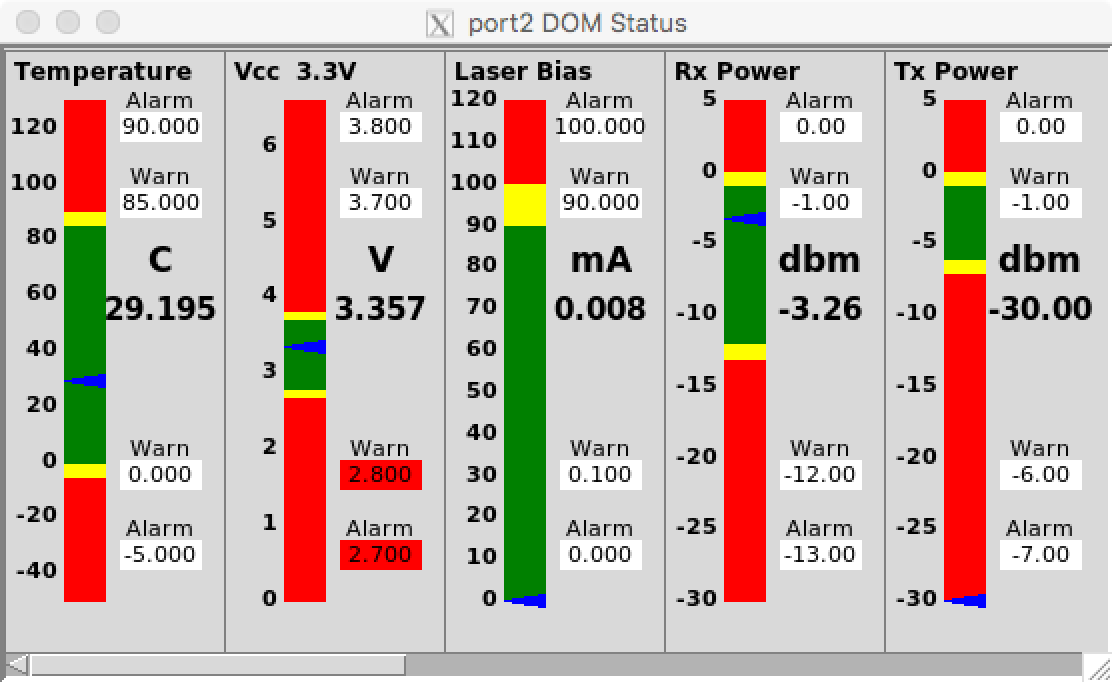Overview
I had a first look at the Open Optical Monitoring (OOM) project of the Open Compute Project (OCP). OOM is a kernel driver that accesses the I2C management interface of SFP and QSFP modules. It can retrieve inventory data like model, serial number, manufacturor, optical power levels, etc.
It is being picked up by NOSes like Cumulus and [SONiC] (https://azure.github.io/SONiC/). I tested on an EdgeCore AS5712-54X [running Open Network Linux] (http://opennetlinux.org/). I used today’s [latest-DEB8-AMD64-installed.installer] (http://opennetlinux.org/binaries/). There are a couple of applications available, e.g.:
~/oom/apps# python inventory.py
Port Name Vendor Type Part # Serial #
port1 No Module
port2 Juniper SFP FTLX8571D3BCL-J1 AJS1HGXXXX
port3 No Module
port4 No Module
port5 OEM SFP SFP-SX-S 114440XXXX
port6 OEM SFP SFP-SX-S 114440XXXX
port7 OEM SFP SFP-SX-S 114440XXXX
port8 OEM SFP SFP-SX-S 114440XXXX
port9 OEM SFP SFP-SX-S 114440XXXX
port10 OEM SFP SFP-SX-S 114440XXXX
port11 OEM SFP SFP-SX-S 114440XXXX
port12 OEM SFP SFP-SX-S 114440XXXX
port13 OEM SFP SFP-SX-S 114440XXXX
port14 OEM SFP SFP-SX-S 114440XXXX
port15 OEM SFP SFP-SX-S 114440XXXX
port16 OEM SFP SFP-SX-S 114440XXXX
port17 No Module
port18 No Module
port19 AVAGO SFP QFBR-5759AP AVAGMY50XXXX
port20 FINISAR CORP. SFP FTLX1471D3BNL-J1 AN9XXXX
port21 FINISAR CORP. SFP FTLX1471D3BNL-J1 AN9XXXX
port22 No Module
port23 CISCO-AGILENT SFP QFBR-5798L A5002XXXX
port24 No Module
port25 CISCO-AGILENT SFP QFBR-5798L A5002XXXX
port26 OEM SFP SFP-SX-S 11444XXXX
port27 No Module
port28 No Module
port29 FINISAR CORP. SFP FTLX1471D3BNL-J1 AN8XXXX
port30 No Module
port31 No Module
port32 OEM SFP XEN-SFP+10G-LR DCM012XXXX
port33 CIENA-JDS SFP FE0600XXXX
port34 No Module
<truncated>
There is also a nice demo included with live Digital Optical Monitoring. On your switch you start a Python script:
~/oom/apps# python oomjsonsvr.py
This gives access to the optical data via a JSON REST interface. Somewhere on your network you can start the client by installing the OOM Python code and running the demo script:
~/oom/demo# python gui.py -url <switch IP address>
This show the inventory like above in a window and you can right click on a port and choose DOM from the popup menu. This gives the status like the screen shot below that refreshes every second.

It shows current values and upper and threshold values (upper and lower warnings and alarms).
The SFP and QSFP specifications
The SFP and QSFP specifications are maintained by the Storage Networking Industry Association (SNIA). The relevant specs for OOM are [SFF-8472] (https://ta.snia.org/higherlogic/ws/public/download/294/SFF-8472.PDF) for SFP and SFP+ and [SFF-8436] (https://ta.snia.org/higherlogic/ws/public/download/274/SFF-8436.PDF) for QSFP+ and QSFP28. The electrical and power specifications for SFP+ are described in [SFF-8431] (https://ta.snia.org/higherlogic/ws/public/download/268/SFF-8431.PDF). Some other specifications are:
| Specification | Description | |
|---|---|---|
| INF-8074 | SFP (Small Formfactor Pluggable) 1 Gb/s Transceiver | |
| SFF-8079 | SFP Rate and Application Selection | |
| SFF-8089 | SFP Rate and Application Codes | |
| SFF-8431 | SFP+ 10 Gb/s and Low Speed Electrical Interface | |
| SFF-8436 | QSFP+ 10 Gb/s 4X Pluggable Transceiver | |
| SFF-8472 | Diagnostic Monitoring Interface for Optical Transceivers | |
| SFF-8690 | Tunable SFP+ Memory Map for ITU Frequencies |
They are all on the SNIA website.
The Diagnostic Monitoring Interface for Optical Tranceivers
All these modules (SFP and QSFP) have an I2C management interface. I2C is a 2-wire bus protocol with SCL (Serial CLock) and SDA (Serial DAta) signals. On a QSFP+ module, pin 11 is SCL and pin 12 is SDA. On an SFP+ module, pin 4 is SDA and pin 5 is SCL. The I2C bus provides access to the EEPROM in the optical module.
In my current setup it looks like OOM is accessing the /sys filesystem directly via the as5712_54x_sfp driver. OOM also provides a kernel module (optoe) for the I2C controller and various projects have indicated that they will transition to this driver.
This /sys filesytem looks like this:
root@localhost:~/oom/oom# ls /sys/bus/i2c/drivers/as5712_54x_sfp/
10-0050 14-0050 18-0050 21-0050 25-0050 29-0050 32-0050 36-0050 40-0050 43-0050 47-0050 5-0050 54-0050 8-0050 uevent
11-0050 15-0050 19-0050 22-0050 26-0050 30-0050 33-0050 37-0050 4-0050 44-0050 48-0050 51-0050 55-0050 9-0050 unbind
12-0050 16-0050 20-0050 23-0050 27-0050 3-0050 34-0050 38-0050 41-0050 45-0050 49-0050 52-0050 6-0050 bind
13-0050 17-0050 2-0050 24-0050 28-0050 31-0050 35-0050 39-0050 42-0050 46-0050 50-0050 53-0050 7-0050 module
root@localhost:~/oom/oom#